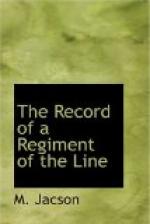The brigade was now split up and placed on the line of communications, and it was thought probable that the Regiment would see no more fighting and that the war would soon be brought to a conclusion. Of the four regiments in the brigade, the Manchester Regiment had been left behind to garrison Jonono’s Kop and the railway line near Elandslaagte, the Devons were left to garrison Ingagane on the railway, and the Rifle Brigade was at Newcastle and between that place and Ingogo at the foot of the Laing’s Nek pass. The Gordon Highlanders were at Ingogo and guarded the railway line still further north.
The Regiment itself was also split up. A detachment of one company under Captain Travers (increased afterwards to two companies) proceeded to occupy Dannhauser, and two companies under Captain Bartlett were ordered to Rooi Pint on the high ground between Ingagane and Newcastle. A battery of artillery was also stationed at this place.
The remaining companies of the Regiment, including a 9th or K company which had been created shortly after the siege, were posted on the low hill overlooking Ingagane railway station.
On June 4th the 1st Cavalry Brigade arrived to form part of the garrison of Ingagane. This brigade was commanded by Brigadier-General Burn Murdoch, who was in charge of the line of communication Newcastle-Dannhauser.
At Ingagane Hill the Regiment found itself again employed in building stone walls. Entrenchments against attack were considered necessary, for it was thought probable that the Boers would attempt to break through from the north-east of the Free State on the west and cross into Utrecht and Vryheid districts. The real danger, however, lay on the east, for the Vryheid district long remained a Boer stronghold, and parties of Boers frequently raided to the Blood River in the immediate neighbourhood of Dannhauser.
It was owing to this that on June 15th a second company was sent to reinforce Captain Travers at Dannhauser. The hill selected by Captain Travers for defence overlooked Dannhauser railway station, and commanded a large extent of ground to the east of the post. This hill was very strongly fortified, and the works on it, designed and built by Captain Travers and his men, were perhaps the best works for protection against musketry fire constructed by the Regiment during the war.
[Illustration: Making Barbed-Wire Entanglement, Ingagane]
News was received daily that thousands of Boers with dozens of guns were on the eastern flank, with every intention of raiding, cutting the line, and attacking Dannhauser. Dundee also, according to the newspapers and the evidence of native scouts, was in deadly peril from attack by Chris. Botha. It was, perhaps, on account of these rumours that a column was formed to reconnoitre Utrecht. In conjunction with another column which moved out from Ingogo, three companies of the Regiment, with the Royal Dragoons and the 5th




